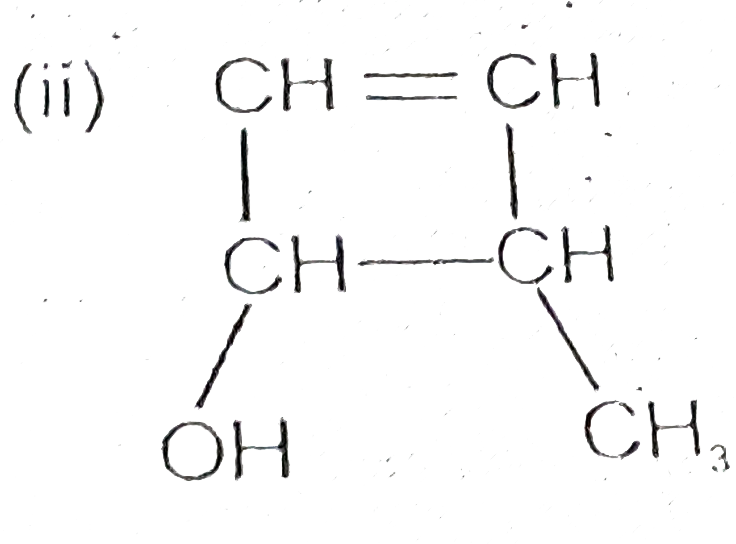Of the two alcohols, (a) CH2=CH−CH2OH and (b) CH2=CH−CH2−CH2OH, which one will react more easily with conc. HCl in the presence of ZnCl2?
To determine which of the two alcohols, (a) CH2=CH−CH2OH (propan-2-ol) and (b) CH2=CH−CH2−CH2OH (butan-2-ol), reacts more easily with concentrated HCl in the presence of ZnCl2, we can follow these steps:
Step 1: Identify the Type of Alcohols
Both alcohols are secondary alcohols.
- (a) CH2=CH−CH2OH has a carbon chain of 3 carbons (propan-2-ol).
- (b) CH2=CH−CH2−CH2OH has a carbon chain of 4 carbons (butan-2-ol).
Step 2: Understand the Reaction with Lucas Reagent
The reaction of alcohols with concentrated HCl in the presence of ZnCl2 is known as the Lucas test. This reagent distinguishes between primary, secondary, and tertiary alcohols based on the rate of reaction:
- Primary alcohols react slowly.
- Secondary alcohols react moderately.
- Tertiary alcohols react quickly.
Step 3: Compare the Reactivity of the Two Alcohols
Since both alcohols are secondary, we need to compare their structures:
- The first alcohol (a) has a shorter carbon chain (3 carbons).
- The second alcohol (b) has a longer carbon chain (4 carbons).
Step 4: Analyze the Effect of Carbon Chain Length
Shorter carbon chains generally lead to faster reactions due to less steric hindrance. The longer carbon chain in (b) may create more steric hindrance, making it less reactive compared to the shorter chain in (a).
Conclusion
Based on the analysis, the first alcohol (a) CH2=CH−CH2OH will react more easily with concentrated HCl in the presence of ZnCl2 compared to the second alcohol (b) CH2=CH−CH2−CH2OH.
Final Answer
The first alcohol, CH2=CH−CH2OH, will react more easily with concentrated HCl in the presence of ZnCl2.
---
Both alcohols are secondary alcohols.
- (a) CH2=CH−CH2OH has a carbon chain of 3 carbons (propan-2-ol).
- (b) CH2=CH−CH2−CH2OH has a carbon chain of 4 carbons (butan-2-ol).
The reaction of alcohols with concentrated HCl in the presence of ZnCl2 is known as the Lucas test. This reagent distinguishes between primary, secondary, and tertiary alcohols based on the rate of reaction:
- Primary alcohols react slowly.
- Secondary alcohols react moderately.
- Tertiary alcohols react quickly.
Since both alcohols are secondary, we need to compare their structures:
- The first alcohol (a) has a shorter carbon chain (3 carbons).
- The second alcohol (b) has a longer carbon chain (4 carbons).
Shorter carbon chains generally lead to faster reactions due to less steric hindrance. The longer carbon chain in (b) may create more steric hindrance, making it less reactive compared to the shorter chain in (a).
Based on the analysis, the first alcohol (a) CH2=CH−CH2OH will react more easily with concentrated HCl in the presence of ZnCl2 compared to the second alcohol (b) CH2=CH−CH2−CH2OH.
The first alcohol, CH2=CH−CH2OH, will react more easily with concentrated HCl in the presence of ZnCl2.
Topper's Solved these Questions
- BOOK - ICSECHAPTER - ALCOHOLS, PHENOLS AND ETHERS EXERCISE - EXERCISE (PART-II Descriptive Questions) (SHORT ANSWER QUESTIONS)116videos
ALCOHOLS, PHENOLS AND ETHERS
- BOOK - ICSECHAPTER - ALCOHOLS, PHENOLS AND ETHERS EXERCISE - EXERCISE (PART-II Descriptive Questions) (LONG ANSWER QUESTIONS)20videos
ALCOHOLS, PHENOLS AND ETHERS
- BOOK - ICSECHAPTER - ALCOHOLS, PHENOLS AND ETHERS EXERCISE - EXERCISE (PART-I Objective Questions) (Correct the following statements)15videos
ALCOHOLS, PHENOLS AND ETHERS
- BOOK - ICSECHAPTER - ALCOHOLS , PHENOLS AND ETHERS EXERCISE - SOURCE BASED QUESTIONS4videos
ALCOHOLS , PHENOLS AND ETHERS
- BOOK - ICSECHAPTER - ALDEHYDES, KETONES AND CARBOXYLIC ACIDSEXERCISE - EXERCISE (PART-II DESCRIPTIVE QUESTIONS) ( LONG ANSWER QUESTIONS)478videos
ALDEHYDES, KETONES AND CARBOXYLIC ACIDS
Similar Questions
Knowledge Check
- Question 1 - Select One or More
CH3CH2−OH can be converted to CH3CH2CN by the following reactions :
ACH3CH2OH+KCNΔ−−→BCH3CH2OH+HCNΔ−−→CCH3CH2OHTsCl−−→KCN−−→DCH3CH2OHSOCl2−−−→KCN−−→
A solution of aqueous of KOH hydrolysis CH3CHClCH2CH3andCH3CH2CH2CH2Cl. Which one of these is more easily hydrolysed.?
View SolutionThe IUPAC name of CH2=CH−CH2−OH is
View SolutionIUPAC name of CH2OH−CH2OH is
View SolutionWrite its bond line formula
(i) CH3CH(OH)CH2CH2OH View Solution
View Solution
CH3−CH2−OH
In the given reaction A & B are respectively:View SolutionIn the given reaction
CH2=CH−CHO[X]−−→CH2=CH−CH2OH
[X] will beView SolutionGive IUPAC name for each of the following
CH2OHCH2CH2CH2OHView Solution
